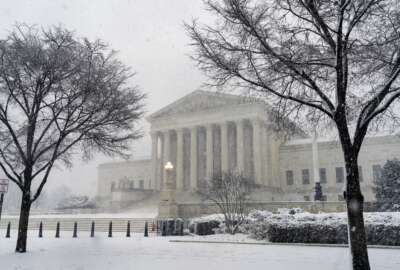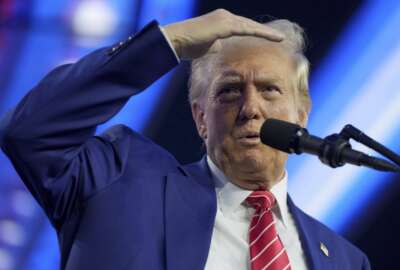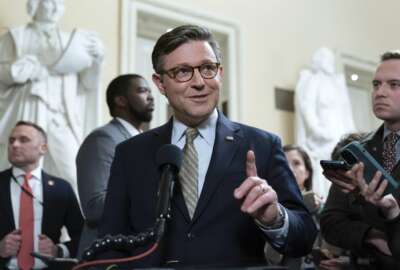Why Harris, Trump should both accept GSA’s help for transition planning
Kamala Harris and Donald Trump have just days to accept GSA’s offer of help on presidential transition planning, the Partnership for Public Service warned.
Regardless of who steps into the Oval Office in January, the presidential transition planning that’s supposed to be underway now for both Vice President Kamala Harris and former President Donald Trump is a daunting task — and a responsibility that packs a lot of punch.
On one hand, a transition from a president to a sitting vice president, who would likely have relatively aligned platforms, may seem like it would be a relatively smooth changeover. But in 1988, the last time that type of transition actually happened, moving from Ronald Reagan’s second term to the George H.W. Bush presidency was one of the “worst transitions of modern times,” said Max Stier, president and CEO of the Partnership for Public Service.
That’s because ahead of the presidential transition to Bush, Reagan asked for the resignation of all his top appointees, intending to give Bush the flexibility to appoint whomever he wanted for his cabinet. Instead, Reagan’s decision created anxiety, confusion and even resentment in the transition process, Partnership officials told reporters during a press conference Monday.
“What you saw from Reagan to Bush were expectations that were not met — that this would be a third term, when it was in fact President Bush’s first term,” Stier said. “These are difficult waters in ordinary times, and the world has only gotten more complicated and more dangerous. What you’re dealing with [now] has substantially more complication and importance.”
Many political appointees were ultimately held over between the Reagan and Bush administrations, but the initial confusion demonstrates “one reason that having a very clear communication strategy about retention across that transition would be very helpful,” said Valerie Smith Boyd, director of the Partnership’s Center for Presidential Transition.
On the other hand, Stier said the other worst presidential transition in modern history occurred in 2016 with the move from former President Barack Obama to Trump. That’s because when the Trump administration stepped in, officials “tossed aside” all the transition planning work that had occurred in the months leading up to the new presidential term, Stier explained.
“That created all sorts of trouble for the Trump administration at the front end,” resulting in relatively few political appointments and executive orders in the early days of the administration, Stier said.
How GSA can help
Those types of unexpected shifts are exactly why Partnership officials are urging both Harris and Trump to accept the offer of transition planning support and resources from the General Services Administration. Under a 2010 law, GSA is required to offer furnished office space, office supplies, a secure IT network, computers and on-site security to both major political party’s campaigns in the months leading up to the November election.
“All of these things may sound straightforward, but a [transition planning] team will have an incredible amount of work to do after the election when the outcome is known,” Smith Boyd said. “[They have to] hire 4,000 political appointees — 1,300 of which require Senate confirmation — and prepare to assume the massive responsibility of the operations and management and services of over 400 federal entities.”
The upcoming presidential transition will also be the first since the passage of the Presidential Transition Improvement Act in 2022, which changed GSA’s involvement in the process. After delayed support from GSA during the 2020 presidential transition, the 2022 law discontinued the process of “ascertainment,” and paved the way for automatic and more immediate support services from GSA for the incoming president.
Smith Boyd said it’s imperative that both transition teams have the right infrastructure and organization in place so they can, for instance, conduct meetings with agencies and manage resumes for making political appointments, should they win the election. GSA can also facilitate introductions for candidates to get access to resources from other agencies.
“When the teams would like to initiate the security clearance process for eligible members of their teams [and] be prepared to access classified information from agencies, GSA can help identify the right points of contact,” Smith Boyd said. “To actually have that communication with them is very valuable to really get to the heart, when they have so little time to have access to resources from federal agencies to be prepared.”
Time is running short for Harris and Trump to latch onto GSA’s help. Each campaign’s transition team has just until Sept. 1 to accept GSA’s offer and sign a memorandum of understanding clarifying the exact parameters that the pre-election transition support will entail.
Harris, Trump both behind on transition planning
For this election cycle, Stier and Smith Boyd said taking advantage of GSA’s resources will be especially crucial, as both Harris and Trump are already far behind where they should be on their presidential transition planning. In just the last week or so, Harris and Trump both named their transition team leads to organize and set up the policies and personnel that will step in, depending on who wins the election. But despite taking that step, Partnership officials warned that the delays in transition planning could still have harmful impacts down the road.
“Modern presidential candidates have started their transition work substantially earlier, in the springtime of the election year, because of a recognition of the lift that is really involved,” Stier said. “It is possible to try and catch up, but the reality is that both candidates have a lot to do.”
In past election cycles, previous presidential campaigns that began transition planning in the spring would have had transition teams already on board. That means, by this point in the year, they’d already be working on vetting resumes of potential political appointees, determining how to turn campaign promises into action and understanding the inner workings of agencies.
“That has taken hundreds of people in a transition planning operation,” Smith Boyd said. “Both candidates may feel a reasonable degree of confidence that they know what’s facing them. The Trump team, of course, was in office just four years ago, in fairly recent memory. The vice president has full access to information facing federal agencies. But each would be establishing their own new term.”
While building the “scaffolding” of an administration, Stier said the tasks are generally the same for both Harris and Trump, but the processes will have significant differences. For instance, it’s more likely Harris may hold over some number of political appointees from the Biden administration, if she wins the election.
“And there’s enormous value in doing so, because it means that you have continuity of people who really understand the lay of the land and how to operate effectively,” Stier said. “For those that are Senate confirmed, very importantly, they do not be need to be confirmed again for those same jobs, and that’s a particular value today when the confirmation process is so broken.”
The Biden administration has seen relatively strong retention of political appointees throughout the course of the term. Still, in the case that Harris does win the election, nothing will be for certain. Some appointees may want to stay in the administration, but others will opt to leave because the jobs are “incredibly difficult,” Stier said. And if she’s elected, Harris may have entirely different ideas about who she wants in those positions.
Copyright © 2025 Federal News Network. All rights reserved. This website is not intended for users located within the European Economic Area.
Drew Friedman is a workforce, pay and benefits reporter for Federal News Network.
Follow @dfriedmanWFED






